[:de]Ich liebe Herausforderungen.
Leider bin ich außerdem oft auch sehr umtriebig. Die Neugier und Suche nach Aufgaben treibt mich voran. Immer möchte ich etwas Neues ausprobieren. Daran herumtüfteln und dann wenn ich es kann, aufbrechen zu neuen Ufern und wieder Neues finden und versuchen zu meistern…
Da ich für die Puppenmitmacherei wie hier berichtet zum ersten Mal eine so große Puppe von 65 cm machen wollte, musste es für die Haare natürlich auch etwas besonderes sein.
Schon vor einiger Zeit habe ich ja bereits selbst Mohair Wolle gefärbt. Zunächst hatte ich also überlegt, davon eine Perücke zu häkeln. Aber dies schien mir auch in Anbetracht der Kopfgröße nicht so ganz passend. Es sollte auch da etwas anderes werden.
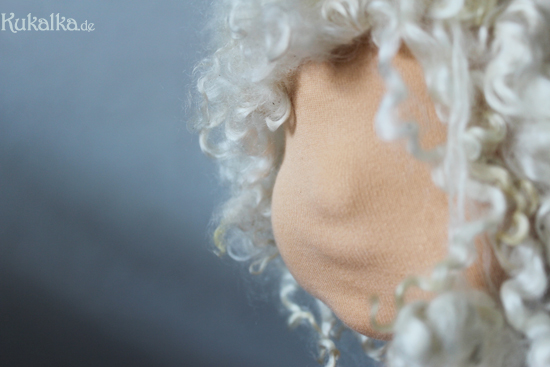
Puppenhaare aus Schafslocken
Schon lange wollte ich nämlich mal Schafslocken als Haar für meine Puppen verwenden. Zum Glück gibt es unweit von hier einen alten Familienbetrieb mit allem was das Schaf so hergibt. Und auch Schaflocken in allen Variationen und Farben sind dort vorrätig. Ich hatte schon ein ganz bestimmtes Bild vor Augen, als ich den Laden betrat…
Jedoch, ich liebe ja Herausforderungen. Da war es klar, dass der kleine Korb mit so wunderbar nach Schaf riechender Rohwolle mich magisch anzog. Die kompetente Verkäuferin versicherte mir noch, es sei gar nicht sooo schwierig die Wolle selbst zu säubern und sie habe das selbst auch schon gemacht.
Umtriebig und neugierig wie ich bin, mag ich es mir auch nicht einfach machen und sagte dann spontan und leicht hin: “Ach, na klar- ich nehm dann mal die Rohwolle”. Denn wie schwierig kann das schon sein, die Wolle selbst zu waschen und zu säubern?!… Oh, little did I know – Aber ich liebe ja Herausforderungen.
Rohwolle waschen
Mit dem Sack, voll mit wunderbar nach Schaf duftenden, Rohwolle daheim angekommen habe ich diese zunächst erst einmal besehen und dann erst realisiert, dass dies doch ein etwas weittragenderes Unterfangen werden würde. Also habe ich mich daraufhin in die Recherche gestürzt und bin zum Glück auf einige Artikel (hier oder hier) und Videos (das oder auch das) gestossen, die ganz gut erklären, wie Rohwolle nun genau gewaschen und behandelt werden sollte….
All dies Wissen im Hinterkopf, habe ich dann also zunächst die Wolle auf einem großen Tuch ausgebreitet und so weit möglich alles an Stroh und Dreck aus den Locken gepflückt.
Allein das dauert schon einmal ein Weilchen.
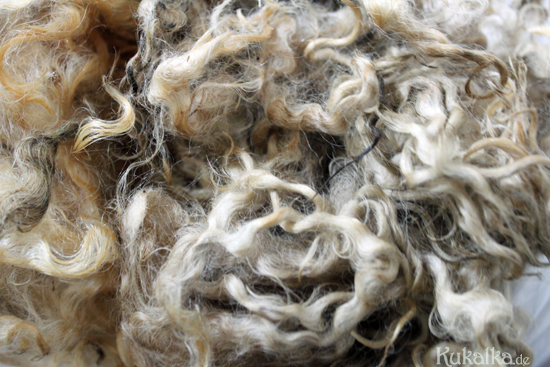
Dann habe ich einen großen Behälter mit lauwarmem Wasser und etwas Wollwaschmittel gefüllt, um so erst einmal den groben Dreck los zu werden.
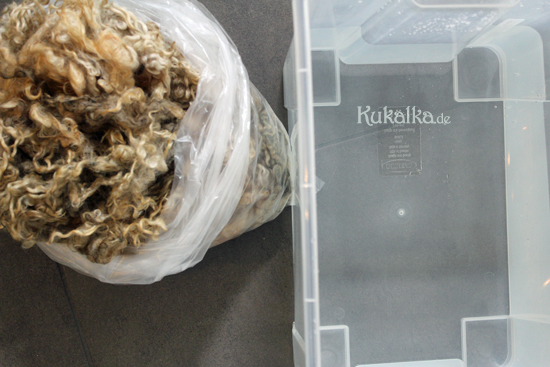
Eine ganz schöne Brühe war das. Es bedarf tatsächlich so einiger “Waschgänge”, in denen das Wasser immer wieder komplett gewechselt werden muss, bis man die weissen Locken allmählich wieder erahnen kann.
Wichtig ist hier auch mit warmem Wasser zu arbeiten, da man sonst das Wollfett nicht herausbekommt. Man kann die Wolllocken ganz vorsichtig und leicht im Wasser bewegen, um sie besser zu säubern. Allerdings ist hier Vorsicht geboten, denn man will ja nicht, dass die Wolle durch zu viel Bewegung und Reibung zu verfilzen beginnt.
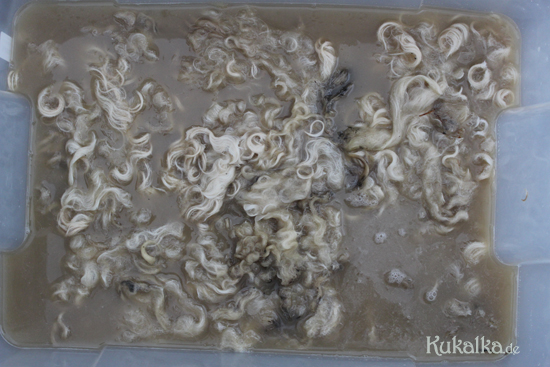
Dies alles dauert dann auch schon mal wieder ein Weilchen.
Sobald das Wasser dann aber beim Abgießen klar ist, kann man daran gehen die Locken ein letztes mal unter fließendem Wasser auszuspülen. Wieder gaaaanz vorsichtig, um die Wolle nicht doch noch zu verfilzen.
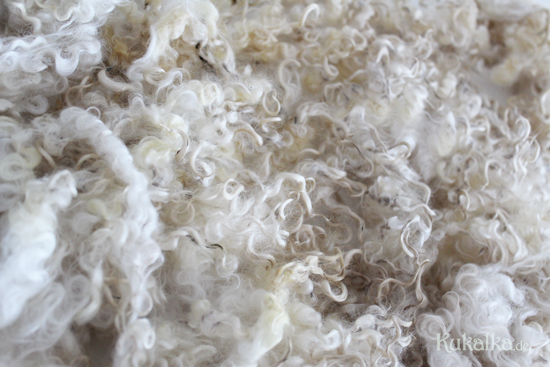
Anschließend sollte die Wolle vorsichtig ausgewrungen werden. Ich habe die feuchte Wolle dann einfach gleich in der Badewanne auf dem Wäscheständer, auf dem ich vorher ein großen Badehandtuch ausgelegt hatte (es tropft ja evtl. noch Wasser aus der sehr saugfähigen Wolle heraus), über Nacht trocknen lassen. Sollte die Wolle am nächsten Tag immer noch nicht ganz durchgetrocknet sein, so sollte man das Tuch darunter wechseln und die Wolle wenden und nochmals mindestens 12 Stunden warten.
Dies alles dauert also wieder ein Weilchen.
Ist die Wolle dann schließlich trocken, kann man sie von den letzten eventuell noch verbliebenen Dreck- und Strohfusselchen befreien. Gute Dienste tut hier eine Tierhaarbürste, mit der man wieder gaaanz vorsichtig nur die Stelle mit den Dreckfusseln bearbeitet und so letzte Reste einfach rauskämmt.
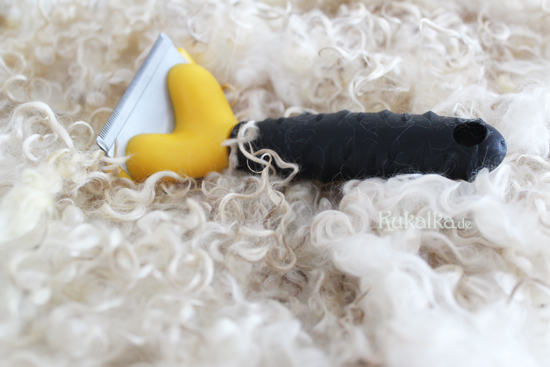
Generell sollten die Wolllocken aber nicht gekämmt werden, da sich sonst ihre Struktur ganz verliert. So blieb mir zum Schluß auch nur noch den Rest mit der Hand vorsichtig aus der Wolle zu zupfen. Zum Glück war dank Vorarbeit und den diversen Waschgängen aber auch nicht mehr viel zu reinigen.
Trotz allem dauert auch dies wieder ein Weilchen.
Puppenhaare aus Schafswolllocken
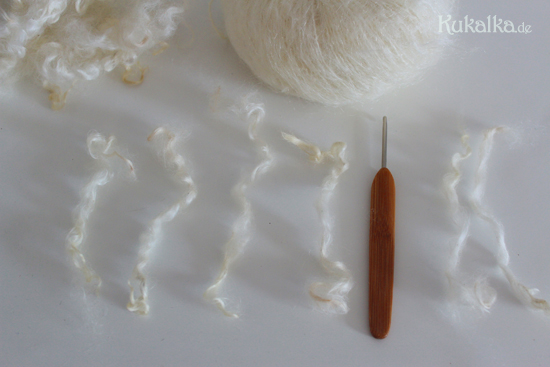
So ist die Wolle irgendwann dann endlich wunderbar duftig, sauber und weiss.
Also bereit zur Weiterverarbeitung:
Wie bereits eingangs erwähnt, sollte aus den Locken ja die Haarpracht für meine Puppenmitmacherei Puppe entstehen.
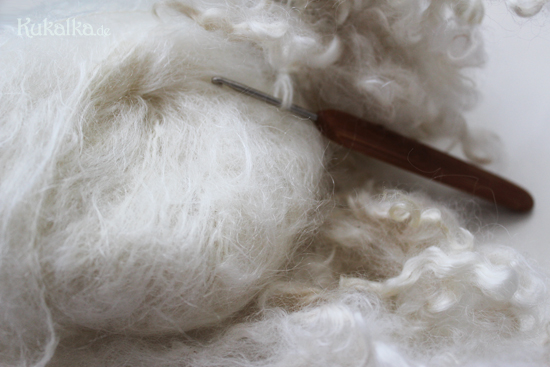
Also habe ich aus den Schafslocken zunächst einzelne Strähnen abgeteilt und bereit gelegt.
Aus der farblich passenden naturweissen Mohairwolle habe ich dann wie gewohnt begonnen eine Perücke zu häkeln. Die einzelne vorbereiteten Wollocken werden dann alle paar Maschen einfach mit in die Perücke eingehäkelt.
Tja und wer nun wissen will, wie die Haare dann fertig auf dem Puppenkopf aussehen, der darf auf meinen nächsten Eintrag zur Puppenmitmacherei gespannt sein: ⇒ Hier.
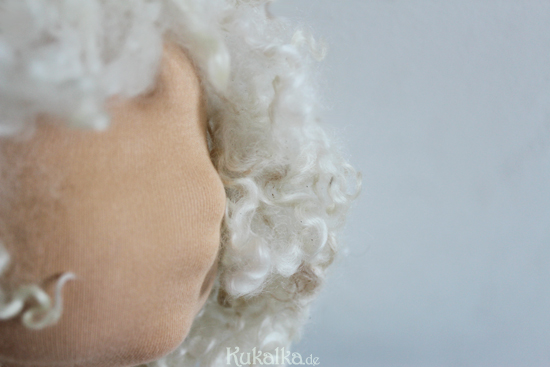
PS:
Und wer jetzt immer noch nicht genug von Puppenhaar hat, der sollte zu Fabiola von Fig & Me rüberklicken, denn sie hat hier gerade einen wunderbar umfassenden Blogpost zu dem Thema verfasst….
PPS: Verlinkt beim creadienstag.[:en]I love challenges.
Unfortunately, I’m also often very go-getting. The curiosity and search for tasks keeps me going. I always want to try something new. Fiddling with a topic only to go search for something new and exciting as soon as I master it.
Since I wanted to try out something different this time around for the first big doll I am creating during the “Puppenmitmacherei”, of course it had to be something special for the hair, too.
Some time ago I already died mohair wool with Kool-Aid myself. At first I had wanted to crochet it into a wig just like I usually do. But then it did not seem to fit well with this special doll. No, it had to be something different this time…

Dollhair from Sheepwool Locks
By now I have long wanted to try using sheep wool curls as hair for my dolls. Luckily, not far from where I live there is an old family business called wool factory. They have all sorts of carded wool. And also sheep locks in all variations and colors are available there.
I had a very specific image in mind, when I walked into the store. However, I do love challenges. So when I entered the shop I was instantly drawn to the small basket with raw wool smelling wonderfully of nature and sheep. It attracted me magically. The competent saleswoman then assured me that it was not sooo difficult to clean the wool myself and said she herself has done so often already.
Curious as I am and always up for the challenge I then spontaneously said: “Oh, well – I’ll take the raw wool!” After all how difficult could that be cleaning the wool by myself at home?! … Oh, little did I know!
But like I said – after all I do love challenges.
Washing Raw Wool
So I arrived with the bag full of wonderful smelling sheep’s raw wool at home. Optimistically I opened the bag and started looking at the wool and sorting the locks. Soon I realised this would be a longer undertaking. So I jumped right in the research and fortunately found in some articles online (here or here) along with some videos (that or this) that explain very well how raw wool should now be accurately washed and treated ….
With all this knowledge in mind, I therefore first spread out the wool locks on a large cloth and started picking straws and grime from the curls as far as possible.
Well, that took a while.

Then I fetched a large container and filled it with lukewarm water and a little wool detergent, to get rid of the first heavy soiling.

Woah. That was quite the broth. It really needs several “washes”, where the water must be completely changed. Repeatedly. Until the white of the curls gradually comes through again.
Also it is important to work with warm water, because otherwise you will not get rid of the lanolin elicits. You can move the wool curls very gently and easily in the water to clean out the dirt faster. However, caution is necessary, because you do not want the wool beginning to felt by too much movement and friction.
Well, that took a while.

Once the water is clear when pouring out the container, I could rinse off the curls with clear water. Again being sooooo careful not wanting to make the wool felt.

Subsequently, the wool should be wrung out carefully. I then simply have put the wet wool on the drying rack on which I previously have places a large bath towel. Also it is best to place the drying rack in the bathtub since the wool may still be dripping water because it is very absorbent. Then I let it dry overnight.
If the wool is still not completely dried by the next day, you should change the cloth underneath and let it dry some more – at least 12 hours.
Well, this also took a while.
Hopefully the wool by then has completely dried. So it now can be freed from the last possible remaining dirt and straws. An animal hair brush can be of good assistance with this task. You should be very carefull combing out the dirt.

Generally however, the wool curls should not be combed at all, otherwise they can completely lose their structure. So I had to gently pluck the little dirt remaining from the wool by hand. Fortunately, thanks to the proper cleaning beforehand and the various washes, it was not too much.
Despite all, this again took a while.
Doll hair from wool locks

Thus, the wool by now is finally clean and white.
Therefor ready for further processing:
As already mentioned, the hair was supposed to be worked into a wig for my Puppenmitmacherei doll.

So I initially I then divided individual strands from the sheep curls and placed them on the table ready to be worked into the crocheted cap.
From the matching color of natural white mohair wool I started to crochet a wig cap as I usually do for my dolls hair.
But then every few stitches I simply took a strand of the locks and crocheted it in with the wig:
Well and if you would like to see how the hair turned out and looks all finished on the doll’s head, you can look forward to my next blog post for the “Puppenmitmacherei” on wednesday. ;)
⇒ Here.

Please don’t forget to follow my blog or my pinterest boards and like my facebook page to keep up with more of my dollmaking related posts!
Thanks for reading,
Nat
PS:
And if you still want to read more on the subject of doll hair, be sure to also visit Fabiola of Fig & Me, because she recently has written a wonderfully comprehensive blog post on this topic here…[:]
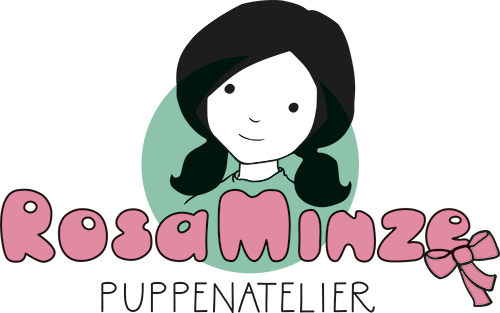






Hallo RosaMinze,
es grüßt dich Simone von der Englhaus-Heartmades Manufaktur, auch eine leidenschaftliche Puppenmacherin.
Ich mache meine Püppchen ( mit beweglichen Ärmchen und Beinchen) mit handgehäkelten Miniperücken aus Mohair oder Seide und meist in verschiednen Farben, so dass sie zum Typ des kleinen Wesen gut passen.
Auch ich habe eine große Freude am Herstellen dieser kleinen Kunstwerke und wenn ich sie dann doch verkaufe, ja…manchmal fällte es mir gar nicht so leicht.
Du hast einen sehr schönen Auftritt , alles Liebe für dich und deine Puppenkunst.
Grüße von Simone